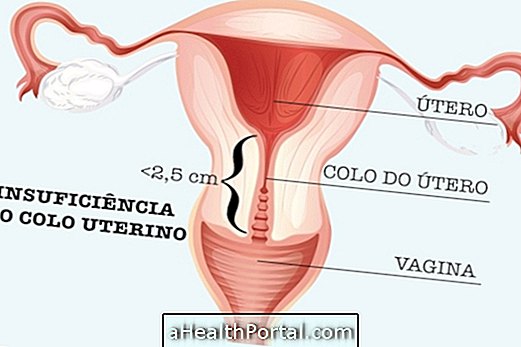Failure of the cervix is when the cervix is less than 2.5 cm during pregnancy, which can have serious complications such as increased risk of miscarriage or facilitating preterm delivery.
The cervix is the final part of the uterus and is formed by a cartilaginous tissue that separates the body from the uterus from the vagina. The uterine cervix has a small opening that allows the menstrual to exit and the sperm enter, but it is usually completely closed. During pregnancy it is expected that it is closed so that the baby can grow properly and only at the end of gestation is that it should decrease in size because it will gradually open or be erased so that it can allow the passage of the baby to birth.
So when the woman discovers that her cervix is open, erased or diminished during pregnancy, this means that the cervix is not enough to hold the baby inside the uterus and this is a serious complication that can facilitate birth before the scheduled date.

Symptoms of Cervical Insufficiency
The insufficiency of the cervical isthmus, as it is also known, does not generate symptoms and therefore can only be discovered during the ultrasound. One sign that the cervix is insufficient is dilation of the cervix without any contraction . Some situations that favor this insufficiency are:
- History of abortion or previous preterm birth;
- Have the conization of the cervix;
- Dilation of the cervix during a uterine curettage.
The doctor identifies that the cervix is deficient when it is less than 2.5 cm at any stage of gestation. The exams that can identify this alteration are the transvaginal ultrasonography performed at the 13th gestational week or at the morphological ultrasound performed at the 20 weeks of gestation. Although less common the doctor may also perform another exam called candle of hegar number 8.
How To Treat Cervical Insufficiency
The treatment should be indicated by the obstetrician who is accompanying the pregnancy and has the purpose of deferring to the maximum the birth of the baby, it can be done with:
- Use of progesterone that can be inserted daily into the vagina, such as utragestan;
- Rest while lying down as much as possible to decrease baby's pressure on the cervix;
- Corticosteroid intake to mature the baby's lungs, decreasing the risk of lung complications if he is born before the expected date;
- Cerclage consisting of closing the cervix using stitches.
Cerclage is a surgical procedure that can be performed urgently with spinal anesthesia and sedation, but it is more appropriate to do it between 12 and 20 weeks of gestation. However, it should only be done in women who do not have any infection and yet have some risks such as uterine infection, rupture of the aminotic pouch and contractions that can give birth. Learn how recovery from this surgery is.
Cerclage can be performed at any gestation when it is needed, but after a history of preterm birth or previous abortion, when the woman becomes pregnant again, the doctor may decide to perform the cerclage soon after performing the ultrasound ultrasound and find that the baby is developing good. There are indications for cervical cerclage in these women because after a previous case, there is a 24% chance that the woman will have the same problem in the next pregnancy.
Find out everything you need to know to take care of the premature baby.
How to prevent cervical insufficiency
There is no way to avoid cervical insufficiency but to perform gynecological examinations annually and follow prenatal care during pregnancy are the best ways to discover any change in the reproductive system by performing any treatment that is necessary.
In women who have undergone an abortion or preterm birth due to failure of the uterine cervix in a previous pregnancy or who have undergone curettage or conization of the uterus, the obstetrician may indicate that the uterine cerclage is performed even though the cervix is not yet less than 2.5 cm only to prevent this complication because it may appear suddenly and treatment is not always successful.












-o-que--sintomas-e-tratamento.jpg)









